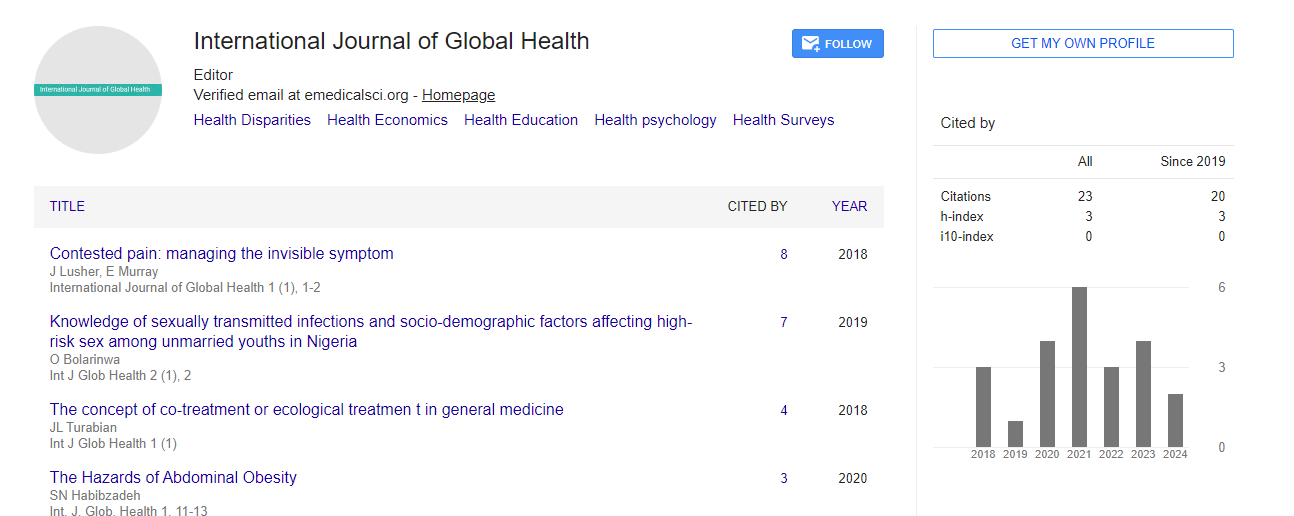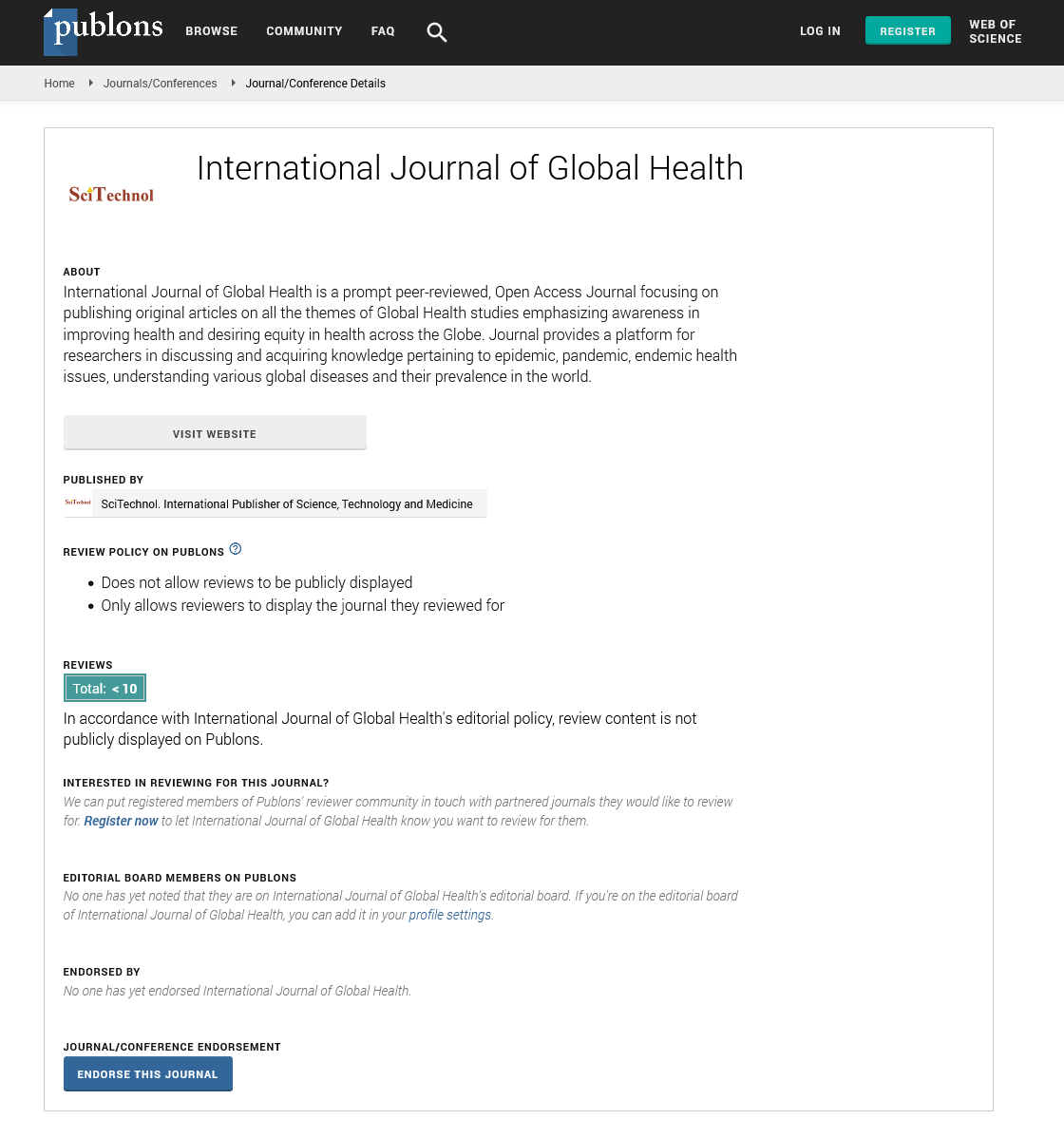Opinion Article, Int J Glob Health Vol: 7 Issue: 3
Awareness in Cervical Cancer: Importance, Prevention, and Education
Jianan Zhang*
1Department of Gynaecology, Wenzhou Medical University, Wenzhou, China
*Corresponding Author: Jianan Zhang,
Spiritual Department of Gynaecology,
Wenzhou Medical University, Wenzhou, China
E-mail: zje6265619@163.com
Received date: 26 August, 2024, Manuscript No. IJGH-24-148981;
Editor assigned date: 28 August, 2024, PreQC No. IJGH-24-148981 (PQ);
Reviewed date: 11 September, 2024, QC No. IJGH-24-148981;
Revised date: 18 September, 2024, Manuscript No. IJGH-24-148981 (R);
Published date: 25 September, 2024, DOI: 10.4172/Ijgh.1000205.
Citation: Zhang J (2024) Awareness in Cervical Cancer: Importance, Prevention and Education. Int J Glob Health 7:3.
Abstract
Description
Cervical cancer is a significant public health concern, particularly for women around the world. It is primarily caused by persistent infection with high-risk types of human papillomavirus (HPV). Despite being one of the most preventable and treatable forms of cancer, cervical cancer continues to be a leading cause of cancerrelated morbidity and mortality among women, especially in low and middle-income countries. Increasing awareness about cervical cancer, its risk factors, prevention strategies and early detection methods is essential in reducing its incidence and improving outcomes. This study discusses the importance of awareness initiatives, prevention strategies and the role of education in combating cervical cancer. Cervical cancer ranks as the fourth most common cancer among women globally, with approximately 604,000 new cases diagnosed and over 342,000 deaths reported annually. The burden of the disease is disproportionately higher in developing regions, where screening and vaccination programs may be limited. In many cases, cervical cancer is diagnosed at an advanced stage, leading to poorer survival rates.
Several risk factors contribute to the development of cervical cancer
HPV infection: Persistent infection with high-risk HPV types is the primary cause of cervical cancer. HPV is transmitted through sexual contact and while most infections resolve spontaneously, some persist and may lead to cancer.
Immunosuppression: Women with weakened immune systems, such as those with HIV/AIDS, are at higher risk.
Smoking: Tobacco use has been associated with an increased risk of cervical cancer.
Long term use of oral contraceptives: Extended use of birth control pills may elevate the risk, although this is a complex relationship.
Prevention strategies
One of the most effective methods for preventing cervical cancer is vaccination against HPV. The vaccines, such as Gardasil and Cervarix, protect against the most common high-risk HPV types associated with cervical cancer. The vaccine is recommended for preteens (both girls and boys) aged 11 to 12, but can be administered up to age 26 or older in some cases. Increasing awareness about the vaccine and its benefits is essential to improve vaccination rates and reduce the incidence of HPV-related cancers. Screening for cervical cancer can detect precancerous changes early, allowing for timely intervention. Key screening methods includes Pap Smear Test detects abnormal cells in the cervix. Women should begin screening at age 21 and continue every three years until age 29. After age 30, women may choose to have Pap tests combined with HPV testing every five years. HPV testing can be done alongside the Pap test for women over 30. Women with negative HPV results can be screened less frequently. Encouraging women to adopt healthy lifestyle habits can also reduce the risk of cervical cancer, quitting smoking can significantly lower the risk of cervical cancer and improve overall health. A balanced diet rich in fruits and vegetables, combined with regular physical activity, supports immune function and overall health.
Role of education and awareness campaigns
Increasing public awareness about cervical cancer is essential for reducing stigma, promoting prevention strategies and encouraging regular screening. Effective campaigns can include community workshops and seminars provide information about cervical cancer, HPV vaccination and the importance of regular screening. Taking advantage of social media can effectively reach younger audiences, disseminating information about cervical cancer prevention and resources. Collaborating with health organizations, schools and community centers can enhance outreach efforts. Training healthcare providers on cervical cancer prevention, screening guidelines and patient education is essential. Healthcare providers should be updated on the latest guidelines for cervical cancer screening and vaccination. Empowering providers to effectively communicate with patients about the importance of cervical cancer screening and vaccination can improve adherence to preventive measures. Women’s organizations can play a vital role in raising awareness about cervical cancer and advocating for improved healthcare access. Initiatives can include supporting networks for women affected by cervical cancer can provide emotional support and promote awareness within communities. Engaging in advocacy to promote legislation that supports HPV vaccination programs, screening accessibility and funding for cervical cancer research.
Conclusion
Cervical cancer remains a significant global health issue, but it is largely preventable through vaccination, regular screening and healthy lifestyle choices. Raising awareness is vital in empowering women to take charge of their health and seek preventive care. Collaborative efforts among healthcare providers, community organizations and policymakers are essential in improving education, access to resources and ultimately reducing the incidence and impact of cervical cancer. By promoting a culture of awareness and proactive health management, we can work towards a future with lower rates of cervical cancer and improved health outcomes for women worldwide.
 Spanish
Spanish  Chinese
Chinese  Russian
Russian  German
German  French
French  Japanese
Japanese  Portuguese
Portuguese  Hindi
Hindi 
